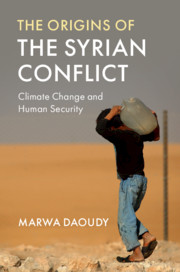17 results
Ten new insights in climate science 2022
-
- Journal:
- Global Sustainability / Volume 5 / 2022
- Published online by Cambridge University Press:
- 10 November 2022, e20
-
- Article
-
- You have access
- Open access
- HTML
- Export citation
References
-
- Book:
- The Origins of the Syrian Conflict
- Published online:
- 05 March 2020
- Print publication:
- 26 March 2020, pp 213-245
-
- Chapter
- Export citation
1 - Climate Change and the Syrian Revolution
- from I - The Context
-
- Book:
- The Origins of the Syrian Conflict
- Published online:
- 05 March 2020
- Print publication:
- 26 March 2020, pp 3-23
-
- Chapter
- Export citation
Acknowledgements and Preface
-
- Book:
- The Origins of the Syrian Conflict
- Published online:
- 05 March 2020
- Print publication:
- 26 March 2020, pp x-xiv
-
- Chapter
- Export citation
I - The Context
-
- Book:
- The Origins of the Syrian Conflict
- Published online:
- 05 March 2020
- Print publication:
- 26 March 2020, pp 1-100
-
- Chapter
- Export citation
2 - The Many Faces of Environmental Security
- from I - The Context
-
- Book:
- The Origins of the Syrian Conflict
- Published online:
- 05 March 2020
- Print publication:
- 26 March 2020, pp 24-76
-
- Chapter
- Export citation
4 - Rules of Ideology and Policy
- from II - Human–Environmental–Climate Security (HECS)
-
- Book:
- The Origins of the Syrian Conflict
- Published online:
- 05 March 2020
- Print publication:
- 26 March 2020, pp 103-149
-
- Chapter
- Export citation
3 - When Geography Rules History
- from I - The Context
-
- Book:
- The Origins of the Syrian Conflict
- Published online:
- 05 March 2020
- Print publication:
- 26 March 2020, pp 77-100
-
- Chapter
- Export citation
Copyright page
-
- Book:
- The Origins of the Syrian Conflict
- Published online:
- 05 March 2020
- Print publication:
- 26 March 2020, pp iv-iv
-
- Chapter
- Export citation
5 - Vulnerability and Resilience
- from II - Human–Environmental–Climate Security (HECS)
-
- Book:
- The Origins of the Syrian Conflict
- Published online:
- 05 March 2020
- Print publication:
- 26 March 2020, pp 150-204
-
- Chapter
- Export citation
Index
-
- Book:
- The Origins of the Syrian Conflict
- Published online:
- 05 March 2020
- Print publication:
- 26 March 2020, pp 246-250
-
- Chapter
- Export citation
Figures
-
- Book:
- The Origins of the Syrian Conflict
- Published online:
- 05 March 2020
- Print publication:
- 26 March 2020, pp vii-viii
-
- Chapter
- Export citation
Tables
-
- Book:
- The Origins of the Syrian Conflict
- Published online:
- 05 March 2020
- Print publication:
- 26 March 2020, pp ix-ix
-
- Chapter
- Export citation
II - Human–Environmental–Climate Security (HECS)
-
- Book:
- The Origins of the Syrian Conflict
- Published online:
- 05 March 2020
- Print publication:
- 26 March 2020, pp 101-212
-
- Chapter
- Export citation
6 - Syria
- from II - Human–Environmental–Climate Security (HECS)
-
- Book:
- The Origins of the Syrian Conflict
- Published online:
- 05 March 2020
- Print publication:
- 26 March 2020, pp 205-212
-
- Chapter
- Export citation
Contents
-
- Book:
- The Origins of the Syrian Conflict
- Published online:
- 05 March 2020
- Print publication:
- 26 March 2020, pp v-vi
-
- Chapter
- Export citation

The Origins of the Syrian Conflict
- Climate Change and Human Security
-
- Published online:
- 05 March 2020
- Print publication:
- 26 March 2020



